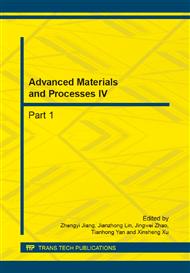p.611
p.615
p.620
p.624
p.628
p.634
p.638
p.642
p.647
Effects of Die Temperature on Microstructure Evolution of 7A85 Aluminum Forging
Abstract:
The free forging process of medium scale specimen was carried out to study the effects of the die temperature on the microstructure evolution of 7A85 aluminum forging. The results show that with the increase of die temperature, the size of the grains and the distribution of dislocations and precipitates of free forging tend to have a high degree of uniformity. Considering the effects of die temperature, the isothermal forging process was applied for the deformation of complex aviation forging. The metal flows smoothly during the isothermal forging process and thus there is little possibility of forming unfill, crack and other defects. The dislocations are evenly distributed during the isothermal forging process. Consequently, there is a relatively uniform distribution of precipitated phases of the aviation forging.
Info:
Periodical:
Pages:
628-633
Citation:
Online since:
September 2014
Authors:
Price:
Сopyright:
© 2014 Trans Tech Publications Ltd. All Rights Reserved
Share:
Citation:


